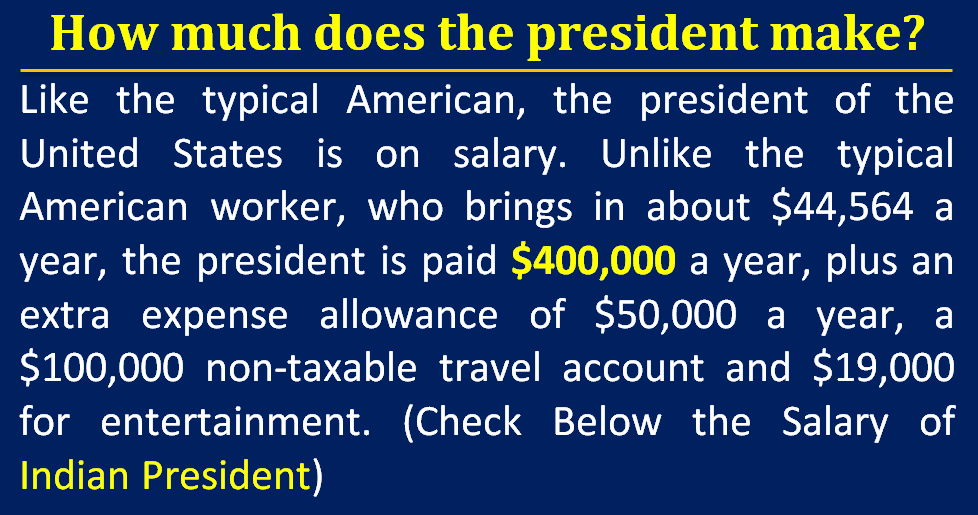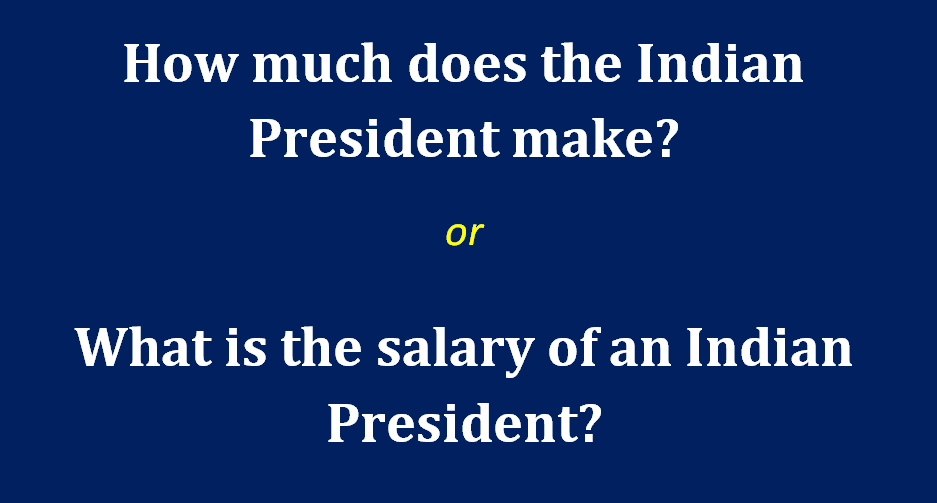 |
| How much does the president make? |
How much does the President of the United States make?
Like the typical American, the President of the United States is on salary. Unlike the typical American worker, who brings in about $ 44,564 per year, the president is paid $ 400,000 per year, plus an additional expense allowance of $ 50,000 per year, a non-taxable travel account of $ 100,000 and entertainment, $ 19,000 is paid for.
Between 1789, when George Washington came into office, and today, there have been five salary increases for the president, most recently in 2001, when Congress doubled the president’s salary. George W. Bush, who took office that year, was the first to benefit from the increase.
- 1789: $ 25,000
- 1873: $ 50,000
- 1909: $ 75,000
- 1949: $ 100,000
- 1969: $ 200,000
- 2001: $ 400,000
In addition to the salary, the president receives free transportation to the presidential limousine, Marine One and Air Force One, and of course, free accommodation at the White House.
Another perk: After leaving office, the former president remains on government payroll, paying an annual pension of about $ 200,000, as well as health care coverage and official travel.
While a salary of $ 400, 000 is enough to place the president among the top 1 percent of earners in America, a former president can rake in more than book deals and speaking gigs. Bill Clinton gives more than $ 75 million speech after leaving White House
President Trump, whose total assets are estimated at $ 3 billion, promised to donate his entire presidential salary. He donated his 2017 third quarter earnings to the Department of Health and Human Services and his fourth quarter earnings to the Department of Transportation.
Therefore, each president received full presidential salary payments before President Donald Trump. While Donald Trump receives $ 1 USD by choice every year. However, in addition to its $ 1 USD every year. He gets all other allowances before the rest of the presidents.
President Trump’s Salary
Trump is making $ 1 per year because he is not accepting salaries as president. At the same time, he is earning millions by golfing at his resorts and foreign dignitaries name him in hotels and resorts.
 |
| Salary of Indian President |
Salary of the Indian President
Salary of the president, VP, speaker, prime minister, and other main officials of the Indian government, both national and state?
- President of India: ₹500,000 (per month)+ Other allowances fixed to President of India.
- Vice President: ₹400,000 (per month)+ Other allowances fixed to Vice President of India
- Prime minister of India: ₹165,000monthly (includes salary received as a Member of Parliament in Lok Sabha)+ Other allowances for the Prime Minister of India.
- Governers: ₹350,000+ Other allowances fixed for Governors of States.
- Chief Justice: ₹280,000+ Other allowances fixed for Chief Justice of India.
- Judges of Supreme Court of India: ₹250,000+ Other allowances fixed for SC Judges.
- Chief Election Commissioner of India: ₹250,000 monthly+ Other
- Member of Parliament of India: ₹50,000
Functions of the President
The President of India has a large number of duties to perform which he has to discharge.
Executive functions
1. Union Head
The President is the head of the Union Executive. Consequently, all executive powers are exercised in his name. The executive power of the Union given to the Union by the President extends to matters in respect of which Parliament has the power to make laws and to conclude treaties and agreements.
2. Appointments
As the head of the executive, the President appoints governors of states, judges of the Supreme Court and members of the High Courts, the Auditor General of India and many other high officials, such as the Finance Commission. Election commission. , Union Public Commission etc.
3. Appointment of Prime Minister and other Ministers
The President also appoints the Prime Minister and other ministers of the Union Council of Ministers in his advice. But here too, like all other appointments, the President can rarely exercise his discretion. He is usually duty-bound to call the leader of the political party, who wins an absolute majority in the Lok Sabha to form the Prime Minister and forms a ministry. He only enjoys certain discretionary powers under specific circumstances. When no political party wins a clear absolute majority, and as a result, no council of ministers can be formed without a coalition of parties, the president can use discretion to appoint the prime minister. Such situations developed in the past.
India has entered coalition politics. And it may happen that no party will gain an absolute majority, and the President may need to exercise his discretionary power for some time to appoint the Prime Minister.
4. Prove majority in Lok Sabha
Union Council of Ministers usually holds office for five years, unless dissolved earlier for some reason. The President must be satisfied that the Council of Ministers has the confidence of a majority of the Lok Sabha. In case of any doubt, he may ask the Council of Ministers to prove his majority in the Lok Sabha, as the Prime Minister Mr. H.D. Deve Gowda was asked by the President after the Congress party withdrew support from the ministry. The President can also dissolve the Union Council of Ministers as per Article 75 (2) of the Constitution, if he finds that the Ministry does not enjoy the support of the chiefs in the Lok Sabha.
5. Supreme Commander
As the head of state, the President is the supreme commander of the armed forces of India and is entitled to declare war or conclude the treaty.
Legislative powers and functions
1. The President is a part of the Parliament
The Central Legislature or Parliament consists of the President and two Houses of Parliament. Therefore, the President is an integral part of the Central Legislature. He shall send summons to the Houses of Parliament from time to time, individually or jointly. The President can give priority to the Houses or any House of Parliament and, if necessary, dissolve the Lok Sabha, the lower house of Parliament. For example, the President resolved the Twelfth Lok Sabha in early 1999 when a motion of confidence in favor of the Vajpayee government was lost in the Lok Sabha.
2. Summons and Address to Parliament
The President can address both houses of Parliament. In such an address, in the first session after the general election to the Lok Sabha and at the beginning of the joint session of Parliament each year, he can give reasons for calling it. In addition to addressing Parliament, the President may, in case of necessity, send a message to the House or to both Houses [Article 86 (2)]. Generally, the President does not send such messages unless he has a serious disagreement with the Council of Ministers.
3. Nomination
The President nominates several members in both the Houses. The main objective of nomination is to ensure adequate representation in Parliament of all sections of the population which are not always attained through multiple elections.
4. Power in relation to Bills
The President has certain functions in relation to passing the Bill. A Bill passed by both the Houses of Parliament requires their consent to become an Act. He can give his assent to a bill or after it is approved in both houses, when a bill is placed before the President, he can give consent. But, if Parliament takes action on the President’s refusal to accept a bill, it passes it for the second time with or without amendment, and presents it to the President for his assent, under Article 111 President. Will not withdraw his consent from there. . In other words, it becomes mandatory to give your consent to it.
In some cases, prior approval of the President is required to enforce any law. For example, a bill to create a new state or change the boundaries of an existing state or states should be placed before Parliament with the prior approval of the President. The money bill is another example where obtaining such approval of the President is a constitutional requirement.
5. Bill passed by a State Legislature
A Bill passed by a State Legislature may also be reserved for the consideration of the President by the Governor of that State. The President is empowered in respect of such matters passed by the State Legislature, where there are matters which are referred to under Article 200 by the State Government.
Power to promulgate ordinances
In addition to being in session of both houses of parliament, the President may enact such ordinances as circumstances require him to do so (Article 123). Such an ordinance may have the same force and effect of an Act of Parliament. Such ordinance shall continue until it is passed by both the Houses of Parliament within the period prescribed. A.k. Roy v. Union of India (1982) proposes that the President’s satisfaction should be in the form of the existence of a situation which makes it necessary for the President to make such publicity on the ordinance.
Financial powers and functions
The President causes the annual budget of the Central Government before the Parliament every year. No proposal to spend money or increase revenue for the purposes of the government can be presented in Parliament without the prior permission of the President.
President’s emergency powers
The Constitution of India empowers the President to declare three types of emergencies:
- National Emergency (Art. 352);
- Emergency for failure of constitutional machinery in a state (Art. 356);
- Financial Emergency (art. 360)